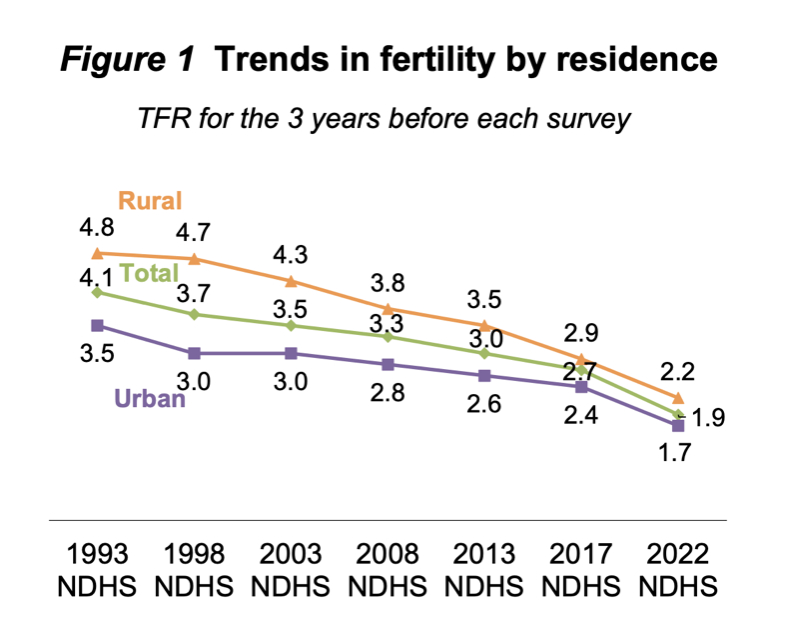April 16, 2024 – How rapidly a country’s population grows has important implications on its citizens well-being. Canada’s native population, for example, has stopped growing and is rapidly ageing, causing worries about the country’s future ability to take care of its non-working elderly.
As the number of those who need support rises, the number who can support them declines. This is now a serious concern for the Republic of Korea and Japan, the two East Asian countries that are already experiencing a worryingly rapid decline in their populations. For a very long time the Philippines has stood as an exception to the global trend in the decline of women’s fertility, a good indicator of how fast a population grows. In 1993 the average number of children that a woman would have by the end of her child-bearing years stood at 4.1, a very high number compared to most other countries like Thailand where the average was less than 1.5 children.
Some observers have argued that this should not be a cause for concern since a rapidly growing population means a growing number of workers who can contribute to faster development. The majority of observers however blame rapid population growth as one of the key reasons why the Philippines has fallen behind its neighbors in delivering a better life for its people. More children means more mouths to feed, to educate, to house and to provide health care. Little of a worker’s produce, whether in the farm or the factory, is left to save, thus undermining his or her ability to raise productivity. Productivity depends not on muscle power alone. Men and women are more productive when they work with other complementary inputs like fertilizers for the farm or machineries in the factory.
In the 20 year period between 2000 and 2020 the Gross Capital formation in Indonesia rose by 16 times and in Vietnam by 19.6 times, while that of the Philippines rose by only 5.4 times. There are, to be sure, other explanations as to why the Philippines has lagged far behind its neighbors in raising the investments needed to make its workers more productive, but the rapid growth of its population is certainly an important explanation. After feeding our children, there was little left for acquiring better tools, better machines, better boats, more fertilizers, etc.
In other words, our fast population growth has been like a heavy load on our backs slowing down our pace of development. A rapidly growing number of people reaching the working ages are unable to find work, and many have been forced to seek employment abroad. Many unable to earn enough in the country sides migrate to the cities eking out a living in whatever way they can, and suffering the misery of living in congested slums of the cities.
Last September the Philippine Statistical Authority released its report on the findings of the 2022 Demographic and Health Survey (DHS) that revealed a very welcome development. This 12th in a series of national DHS surveys conducted every 5years since 1968 found that our Total Fertility Rate (TFR) had declined from 4.1 children per woman in 1993 to 1.9 in 2022. The pace of the decline between 2017 and 2022 was much more rapid than the decline between 1993 and 2017. The TFR among women in rural areas decreased from 4.8 in 1993 to 2.2 in 2022. Among women in urban areas, the TFR decreased from 3.5to 1.7 over the same period.
1 The survey had a national sample of over 30,000 households and nearly 28,000 women age 15 to 49.
The total female fertility rate in the Philippines has reached below-replacement level (fertility levels below 2.1 births per woman) joining many advanced economies in Asia.

According to the Philippine Statistical Authority If fertility were to remain constant at current levels, a woman in the Philippines would bear an average of 1.9 children in her lifetime. Hence, the Philippines now has “below replacement fertility level” of 2.1children. This is for the country as a whole, but fertility differs between urban and rural areas. As one would expect fertility is higher in rural areas than in urban areas where average incomes are lower and where housing is less expensive. On average, rural women give birth to 2.2 children in their lifetime, as compared with 1.7 children for urban women. Interestingly, fertility is low among adolescents (25 births per 1,000 women age 15–19). It peaks at 105 births per1,000 among women age 25–29 and decreases thereafter.
In a recent study Michael Abrigo and Katha Ma-i Estopace of the Philippine Institute for Development Studies (PIDS), observed that the decline in fertility has been progressing since 1973. They contend that “enhancing material measures of well-being is the “most effective contraceptive. ”Contributing as secondary factors are delaying marriage and increasing modern contraceptive use. The authors found that the largest birth decline has occurred
among younger individuals aged 25 to 29, with about 20 births per 100 women over the last five decades. Adolescent fertility rates decreased by half ( at 2.2 births per 100 women in 2022), while births among married or cohabitating women also declined in recent years. For instance in 2022, a married woman may expect to give birth to only 5 children, a stark contrast to 1973, when women were likely to have about 10 children over their lifetime.
2 TheTotal fertility Rate measures the average number of children a woman would have by the end of her childbearing years.
3 Estopace, Katha Ma-i M. & Abrigo, Michael R.M., 2023. "What Drives Female Fertility in the Philippines? Evidence from 50 Years of National Demographic and Health Surveys," Discussion Papers DP 2023-19, Philippine Institute for Development Studies.
Abrigo and Estopace identified the five leading factors contributing to about 60 percent of the observed fertility decline:
: The most dominant factor is improvement in socioeconomic status which accounted for 20.7 percent of the dip in child population
: changing marriage patterns accounted for another 14.5 percent
: increase in family planning use for 14.4 percent
: decline in desired number of children for 6.7 percent, and
: improvement in child survival for 5.6 percent
The authors observed a staggering 90-percent decline in TFRs between 1973 and 2022,equivalent to averting about 3.6 births per woman due to changingmarital patterns.Abrigo and Estopace suggested that female fertility rates are not likely to return to previous levels (before the pandemic) due to rising “opportunity costs” of women’s time and childbearing. What this means is that pregnancy involves leaving one’s job and thus having to make do with less income.
Over the years, the birth decline among younger women aged 15 to 19 was as much as 76 percent mainly on account of shifts in marital trend. The decline is lower among older women - around 40 percent among those aged 20 to 24 and 17 percent among those aged 25 to 29.
Education is also a key factor in predicting marriage timing, with female educational attainment improving considerably over the last50 years. The authors noted that by 2022, about half of married or cohabitating women possessed secondary education, and about a third have tertiary education, compared with only 18 percent and 11 percent, respectively, in 1973. These clearly suggest that enabling more women to reach senior high school, or even better, to have tertiary education, would have the effect of delaying marriages.
As suggested above the decline in fertility rate has important implications for the country’s speed of development. It will mean that the national savings rate can rise faster such as to allow a higher rate of investments without contributing to inflation. This was the experience of Thailand which managed to bring down its fertility rate a few decades earlier (1.61 in 2000) than the Philippines. This demographic phenomenon has escaped the attention of most observers of Philippine development, but it is the silent transformation that underlies what progress we may be seeing today in our country.














